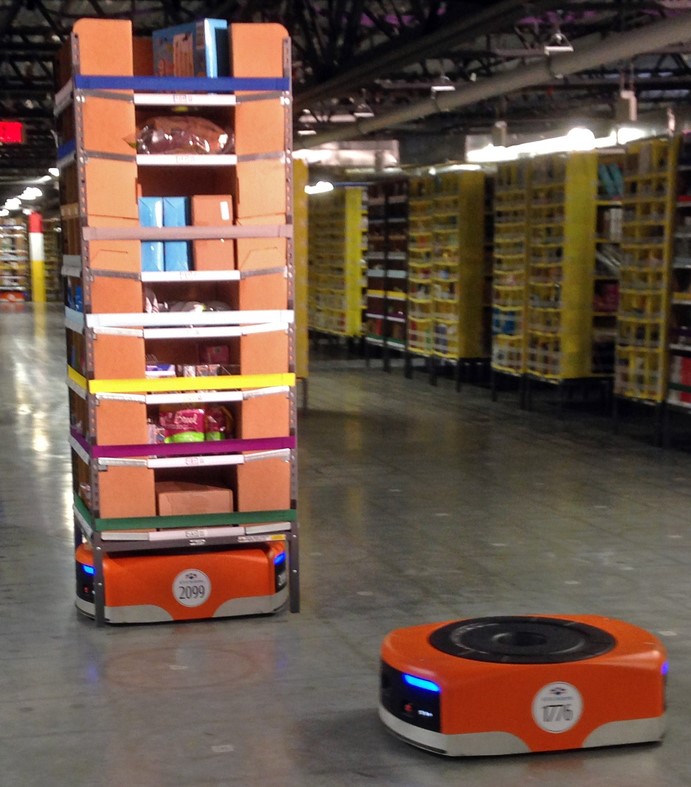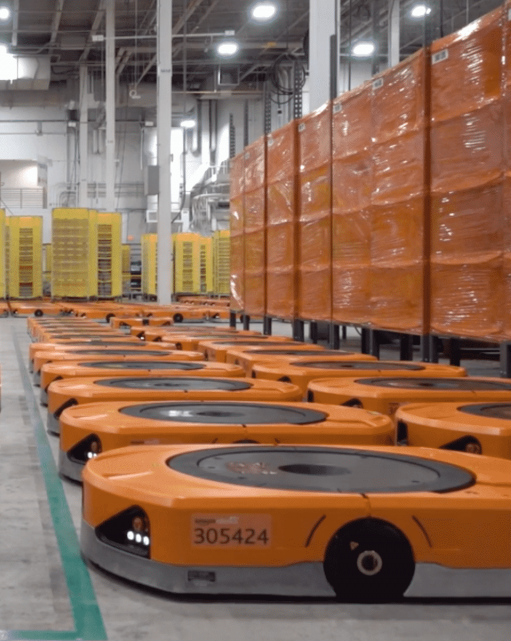Regarding automatization in warehouses, today it has been announced the opening of Amazon’s fourth robotic distribution center in Spain (first was built in 2017), this time located in Murcia, which will join those in Seville and Barcelona with more than 160,000 square meters equipped with Amazon Robotics technology, to support the Amazon operations in Spain and Europe, let’s take a look at robotics within Amazon.
After the adquisition in 2012 of Kiva Systems, most of technology and robotics used by Amazon is developed in-house through its Amazon Robotics division, headquartered on the outskirts of Boston, and is not marketed or sold, it’s developed only to build their empire. It took amazon six years to get 100,000 robots working for them in their warehouses but in just the last two years that number has already doubled to 200,000 robots. Amazon is investing heavily into building their robotics where it is currently investing $ 40 million in a new innovation hub, which will feature research and testing labs, as well as manufacturing space to design and build new robots designed by highly skilled teams.
At amazon’s fulfillment centers robots transport items to humans who then pick and pack them to be delivered. This robot alliance raises a human’s productivity from 100 items packed per hour to around 300 to 400 items an hour. Some of the Amazon robots:

The first in the family coming from Kiva Systems, is called Drive (changing the original name Kiva) and is very easily described if you imagine a Roomba, as well as their bigger cousin Hercules. Both capable of lifting and moving from 450 to 1,300 kilograms of products in a special rack called Pod on the surface on which they operate, called Robotics Field, at a speed from 5 to over 6 km/hour.

The Pegasus, which also moves pods on the robotic fields. However, it is only 19 cm high, 10cm less than the original Kiva. These alone make up 200 000 of amazon’s robots. The Pegasus is also intended to be a generic base for different attachments on top, such as The Pegasus X-Sort Drive which has a different fuctionality as the following video shows.
The technollogy keeps evolving and The Pegasus already has a succesor, The Xanthus, first presented at the Amazon MARS conference in June 2019. This new model is much thinner, has one-third the number of parts, and costs half as much as the original Kiva, and as the Pegasus has the option of different attachments, but in a wider variety. The Xanthus sort bots (similar to the Pegasus X-Sort drive) is used for sorting parcels to different chutes. The Xanthus Tote Mover can move the yellow boxes with items (called totes at Amazon) from picking to packing, and also if needed to multi-sort and gift wrap.
In order to keep adding robotics in the logistic chain, Amazon bought Dispatch in 2017, an urban delivery robot startup and in 2018, Canvas Technology, a robotic startup that specializes in autonomous carts for moving goods near humans. By January of 2019 Amazon starts Field Testing for a new, fully electric delivery system added to the well-known Drone delivery system project – The Amazon Scout – designed to safely get packages to customers using autonomous delivery devices of the size of a small cooler that rolls along sidewalks at a walking pace. For Valantine’s day in 2020 Amazon celebrate their employees with a love story featuringthe very adora-bot Amazon Scout in this cute video.
Artificial inteligence is already being used to predict what you are going to buy before you even go to the amazon website. Since 2015 deep learning AI has been predicting what is going to be bought, and getting it to the nearest fulfillment center, before it is even ordered. This means that when you shop online products are readily available, cheaper to ship and since they are waiting at a center near you they will ship to your doorstep faster. Amazon is also investing 10 billion dollars to build a satellite internet network just like Spacex’s Starlink. Amazon’ s version would require 3236 orbiting satellites and they have already received FCC certification.
In 2020 amazon acquired Zoox for 1.3 billion dollars, which is a self-driving vehicle company. This technology could be used to create self-driving delivery or workhouses vehicles, such as cars and forklifts.
Maybe one day, whole delivery chain will be run by robots, from artificial intelligence predicting what you want to buy to self-driving planes that deliver the goods to a robotic fulfillment center, where self-driving forklifts supervised by drones and driving units and robotic arms get the items packed and send delivery robots that take the packages and deliver to your personal robot at home.


Is very interesting how Amazon is trying to invest in technology no directly related to their business activity but that can improve it in a certain way, or that open future opportunities to expand their services. Thank you for sharing it Belen